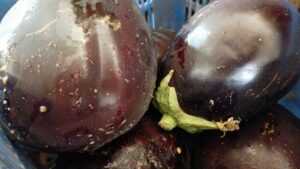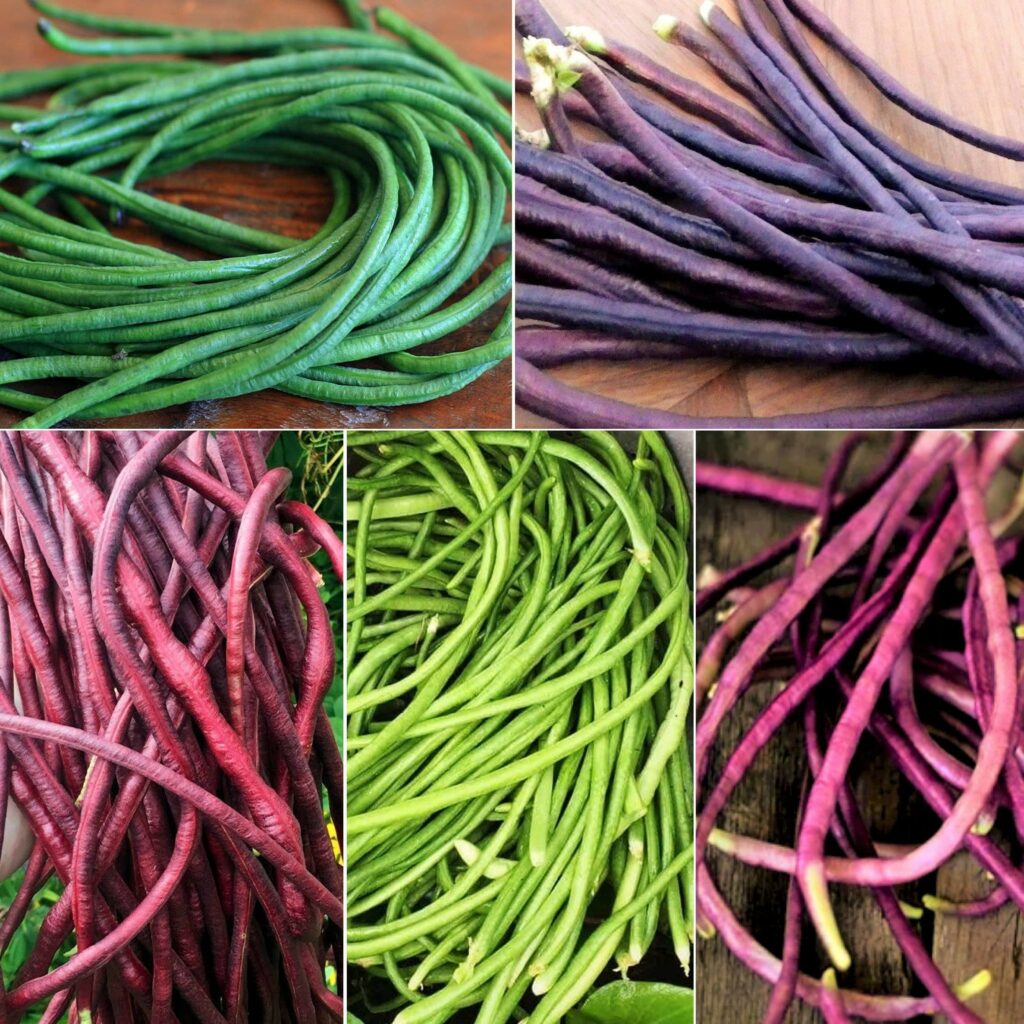Two messages regarding Chubeza veggies:

Our baladi eggplant has grown this year to really big dimenentions. It’s not because it was picked too late, it’s young and fresh and nice, just… big. Enjoy!

And – back to the side dish options – the wonderful hot pepper remembered well from last year. If you wish, you can add it through the order system under the heading: “Chubeza Vegetables and fruits”.
_______________________________________________________
You have captured my heart, my sister, my bride
You have ravished my heart with one of your eyes,
How fair is your love, my sister, my bride,
And the scent of your balms as the fragrance of Levanon,
Come with me from Levanon, my bride,
Come from the lions’ dens, from the mountains of the leopards.
I command you, daughters of Jerusalem,
That you stir not nor awaken my love, till it please.
In Yehudit Ravitz’s lovely rendition of this song with these extraordinary lyrics from the Song of Songs, which to me connect the ravishing lubia, the third sister of the summer bean pod crops, to Valentine’s Day, to the upcoming romantic Tu B’Av holiday, as well as to the bonds between the tribes of modern-day Israel. Connections which were in fact between those who are different from one another, not between those who are similar. Sort of like the connection we made between the three summer bean pods in Chubeza’s field. Their trilogy, which began with the diminutive, hirsute soybean, moved on to the okra, a distinctive bean which is not a legume, and winding up this week with the lubia (Thai yard-long bean).
If you’ve been wondering why the latest green beans you’ve been receiving are so lengthy, coarse, and a bit strange, it’s because they’re not green beans but rather… Thai lubia. We “gift-wrap” them in your boxes in shiny paper. They are indeed a present, albeit rather strange and unique. But don’t expect them to be green beans, because they something else entirely: Meet Iubia. V. unguiculata ssp. Sesquipedalis, a relative of the common bean, chickpea, soy, fava bean, pea and other members of the Faboideae family we so love to nibble.
Said Rabbi Yona:“How did beans get their name? They amuse the heart and tickle the intestines.” – Yerushalmi Talmud (In Hebrew, this is a play on words….)
The ancient bean that grew for Rabbi Yona in the Land of Israel is, in fact, the lubia. During the days of the Mishna, today’s common (fresh/dry) bean was still found mainly in South America and not yet known in our region, while the lubia, which probably originated in Africa, was the most prevalent here.
When Rabbi Yona says that the bean (shu’it) is amusing (mesha’a’sha’at), he must mean “filling and satisfying.” The verb sha’ah in Aramaic connotes plaster, meaning “filling and covering.” The continuation of Rabbi Yona’s words refers to the other, less amusing part of the (dry) beans and the lubia: their tendency to “tickle,” i.e., generate gas within, the intestines…
Wordplay aside, the lubia was honored by our sages to merit a blessing at the Rosh Hashana table “to increase our merits and hearten us.” For me, the amusement to the heart and tickling of the soul is reminiscent of the beauty and abundance that beans and lubia encompass – these plants are strong and lovely, their gentle flowers resemble two butterflies fluttering between the leaves, and the green pods we pick are tasty, filling and heartwarming.
Both green beans and the lubia have fresh and dry versions, in an impressive array of varieties. The green (or yellow, purple, etc.) variety is eaten fresh in soft long green pods, while in the dry version, only the dried seeds are consumed (available too in an impressive array of colors: red, white, speckled, brown, black, spotted…)
At Chubeza, we host the green bean and its yellow sister in springtime. (This year, the green version did not grow well, but we enjoyed an abundance of yellow.) Both grow on bushes. As spring makes way for summer, along comes the long Thai lubia bean, which grows climbing upward, thus we trellis it on polls.
Thai lubia is known as the yard-long bean, bora bean, long-podded lubia, asparagus bean, pea bean, snake bean, or Chinese long bean, and here as Thai lubia. All names relate to this bean’s various characteristics. It originates in Southeast Asia, hence the “Chinese” or “Thai” title, and can reach the hearty length of half a meter (though it’s generally harvested young, at approximately 30 cm. long and 1 cm thick). Thai Lubia is similar to asparagus in diameter and length, or alternatively, a thin green snake (use your imagination.) Its taste ranges between that of green beans and fresh green lubia, whilst the texture is less crunchy than the green bean and more flexible.
To grow, Thai lubia requires a great deal of heat and thrives throughout the sweltering months of summer (unlike green and yellow beans who faint under the scorching sun). It is seeded in late spring, and we trellis it on high poles with a net spread between on which the young plants adeptly climb. We trellis the Thai lubia on either side of the pepper plants in order to share the shade nets. Within three months the flowering begins. On each pole, a pair of beautiful butterfly-like flowers, from which a pair of beans ripens, are attached at the ends like twin green worms:
Unlike green beans, the Thai lubia grows slowly and yields pods only after more than three months (compared to two or less for green beans). But this has its advantages – we can continue harvesting the Thai lubia on and on, till the temperatures drop in wintertime. These beans must be harvested with care, as the bloom pole continues to develop flowers throughout the season.
The Thai lubia can be harvested, like at Chubeza, at a young stage when it’s 30 cm long and 1 cm thick, and used in the same way as one would prepare fresh lubia or green beans. You can also leave the pods to fully mature on the plant and use the black, red or white seeds (depending on the specific variety) as you would use dry lubia pods or any dry bean.
At Chubeza, we grow the green variety which bears black seeds, but throughout Asia there’s a magnificent array of colorful, bountiful types. On the outside, the pods come in green and reddish-purple hues, while the seeds can be black, white, brown or red.

Thai lubia can be used in recipes calling for green beans or fresh lubia, including soups, quiches and fresh salads. In China, it is lightly stir-fried, and is actually the original bean to have been used in stir-fried dishes. It tastes divine with fish and even pickled. The Thai lubia is rich in Vitamin A and contains a good amount of Vitamin C, iron, folic acid and dietary fibers.
Of course, green beans and Thai lubia can be cooked, steamed, roasted, pickled, added to pasta, rice, salad and any vegetable dish. They cheerfully add taste, color and a festive flair to your meal.
The Thai lubia recipes featured on our website range from easy to more complex dishes, all delicious, of course. But if you don’t feel like firing up a cooking flame in this scorching heat, just help yourself to a long snake lubia bean and nibble away!
Enjoy a week full of summer abundance and the true feeling of vacation,
Alon, Bat-Ami, Dror, Orin and the entire Chubeza team
________________________________________________________
WHAT’S IN THIS WEEK’S BOXES?
Monday: scallions/basil/New Zealand spinach, Lettuce, onions, eggplants of various varieties: regular/baladi/finger eggplants, lubia Thai yard-long beans/okra, Amaro Kabocha squash/ butternut squash/spaghetti squash, coriander/parsley, corn, tomatoes, cucumbers, edamame/acorn squash.
Large box, in addition: cherry tomatoes, bell peppers/zucchini/hot peppers, slice of pumpkin/Melon
FRUIT BOXES: Pears, apples/nectarine, bananas, grapes. Large box: also blueberries.
Wednesday: Lettuce, corn, onions, Amaro Kabocha squash/ butternut squash/spaghetti squash, scallions/ New Zealand spinach/basil/eggplants of various varieties: regular/baladi/finger eggplants, cucumbers, tomatoes, okra, parsley/coriander, slice of pumpkin/Melon
Large box, in addition: Bell peppers/zucchini/hot peppers, lubia Thai yard-long beans/edamame/acorn squash, cherry tomatoes
FRUIT BOXES: Pears, grapes, apples/figs, bananas (only small box) Large box: also nectarines.


